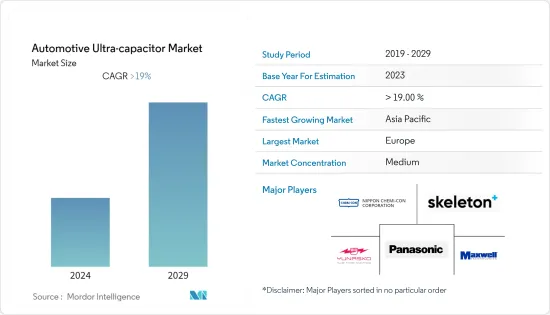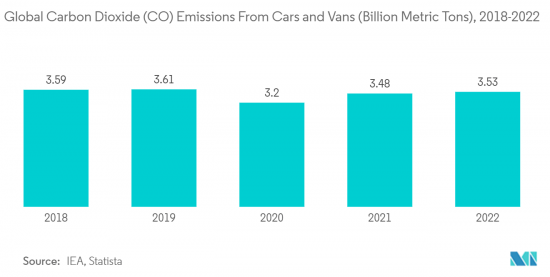PUBLISHER: Mordor Intelligence | PRODUCT CODE: 1404420

PUBLISHER: Mordor Intelligence | PRODUCT CODE: 1404420
Automotive Ultra-capacitor - Market Share Analysis, Industry Trends & Statistics, Growth Forecasts 2024 - 2029

The automotive ultra-capacitor market is valued at USD 1.50 billion in the current year. It is anticipated to grow to USD 4.27 billion by the next five years, registering a CAGR of 19% in terms of revenue during the forecast period.
Over the medium term, the enactment of stringent emissions and fuel economy norms and increasing government initiatives, in terms of subsidies and benefits for increasing the adoption rate of electric vehicles, is expected to witness major growth during the forecast period.
The use of ultra-capacitors expanded the battery load and enabled vehicle manufacturers to achieve fuel efficiency, extended battery life, reduced vehicle weight, and reduced CO2 emissions. Ultra-capacitors are likely to penetrate at a faster rate in all vehicle types, including conventional, hybrid, and electric vehicles, to meet the growing stringent emission rules across the world.
Ultra-capacitors, typically connected in tandem with vehicle batteries, support peak load demands for short intervals (which are less than 30 seconds) encountered during start/stop and regeneration braking applications. The capacity for quick recharge and discharge of high energy offered by ultra-capacitors drove the vehicle manufacturers to deploy them in the start/stop systems and regenerative braking systems. Primary energy sources, like internal combustion engines, fuel cells, and batteries in vehicles, were identified to be inefficient in handling peak power demand or recapturing energy during the applications above.
Automotive Ultra-capacitor Market Trends
Growing Stringent Emission Regulations and Increase in demand for Electric Vehicles
Governments around the world are setting ambitious targets to reduce emissions, and promoting the use of electric vehicles is seen as one way to achieve these goals. For instance, the European Union aims to reduce its greenhouse gas emissions by 55% by 2030, and China set a target of having 25% of new cars sold by 2025 to be electric.
Lithium-ion batteries, which are used in most electric vehicles, saw a significant improvement in terms of energy density, charging time, and overall performance. It made electric vehicles more practical and appealing to consumers.
The growing demand for EVs will lead to technological advancements in battery chemistry and materials. It will require more sophisticated and efficient automotive batteries to ensure safety and performance. Many prominent automobile manufacturers are focusing on building long-term business relationships with automotive battery manufacturing companies. For instance,
- In June 2023, according to a Panasonic Holdings representative, the Japanese corporation intends to increase the output of electric vehicle batteries at a Nevada factory jointly managed with Tesla by 10% within three years. Panasonic Energy plans to add a 15th production line to the Gigafactory Nevada. At a meeting, Panasonic Energy announced a proposal to boost the Nevada factory's manufacturing capacity by 10% by March 2026.
The United States Environmental Protection Agency (EPA) and the National Highway Traffic Safety Administration (NHTSA) are taking initiatives to support the production of eco-friendly vehicles (both passenger vehicles and commercial vehicles) to ensure improved fuel economy and reduced carbon emissions. Through these initiatives, the government is planning to reduce about 3,100 million metric tons of CO2 emissions and save about 6 billion barrels of oil by 2025.
Additionally, the European Union (EU) set emission standards to regulate the CO2 emission levels of passenger cars and commercial vehicles. Transport emissions increased in recent years and now account for a quarter of the EU's total GHG emissions.
As a result, the European Commission, European Parliament, and EU member states are preparing to extend the light-duty vehicles' CO2 regulation to 2025-2030. Furthermore, to meet the standards above, the adoption of the ultra-capacitor is increasing and is expected to witness the same trend during the forecast period.
With the development mentioned above across the globe, the market is likely to witness major growth during the forecast period.

Asia-Pacific and Europe to Dominate the Automotive Ultra-capacitor Market
With the rapidly growing hybrid and electric vehicle sales in the European region, the demand for ultra-capacitors is anticipated to grow to meet the optimal utilization of electric energy in vehicles.
Automotive manufacturers and ecosystem stakeholders in each region began to adapt to the changing regional patterns based on customer needs and preferences. The market studied is expected to expand due to rising vehicle demand and rising living standards around the globe. Furthermore, increased urbanization and an increasing population created a demand for automobiles.
The Asia-Pacific market is expected to grow at a faster pace during the forecast period, owing to development in infrastructure and increased vehicle sales. Furthermore, China is leading the market in terms of revenue due to its massive use of electronic components in vehicles, followed by Japan, Korea, and India.
China is the largest manufacturer and consumer of electric vehicles in the world. Sales targets, favorable laws, and municipal air-quality targets are supporting domestic demand. For instance,
- China imposed a quota on manufacturers of electric or hybrid vehicles, which must represent at least 10% of total new sales. Also, the city of Beijing only issues 10,000 permits for the registration of combustion engine vehicles per month to encourage its inhabitants to switch to electric vehicles.
China is already using supercapacitors in hybrid buses. These buses are equipped with stop-start engines, in which supercapacitors reduce the load on the battery, which increases the lifetime of the batteries.
Due to continuous innovation, Chinese manufacturers are expanding their supercapacitor portfolio. The CRRC, the Chinese state-owned rolling stock manufacturer and the world's largest train builder developed graphene-based supercapacitors that may power electric buses with higher efficiency and for a longer period.
Automotive Ultra-capacitor Industry Overview
The automotive ultra-capacitor market is dominated by several key players, such as Maxwell Technologies, Skeleton Technologies, Kemet Corporation, and Panasonic Corporation, among others. The rapid expansion of manufacturing facilities and an increase in partnership between the vehicle manufacturer and the component manufacturer is likely to witness major growth for the market during the forecast period. For instance,
- In March 2023, Invest Estonia and Skeleton Technologies received USD 53.74 million from the German government and the state of Saxony for its second production unit to be built in Leipzig. Through this fund, the company expanded its products, including ultra-capacitor.
- In October 2022, Skeleton Technologies introduced its SuperBattery and unveiled Shell as a partner. SuperBattery is an innovative technology combining the characteristics of supercapacitors and batteries.
Additional Benefits:
- The market estimate (ME) sheet in Excel format
- 3 months of analyst support
TABLE OF CONTENTS
1 INTRODUCTION
- 1.1 Study Assumptions
- 1.2 Scope of the Study
2 RESEARCH METHODOLOGY
3 EXECUTIVE SUMMARY
4 MARKET DYNAMICS
- 4.1 Market Drivers
- 4.1.1 Rise in demand for Electric Vehicles
- 4.2 Market Restraints
- 4.2.1 High Cost Associated With Product
- 4.3 Industry Attractiveness - Porter's Five Forces Analysis
- 4.3.1 Bargaining Power of Suppliers
- 4.3.2 Bargaining Power of Buyers/Consumers
- 4.3.3 Threat of New Entrants
- 4.3.4 Threat of Substitute Products
- 4.3.5 Intensity of Competitive Rivalry
5 MARKET SEGMENTATION (Market Size in Value (USD))
- 5.1 By Application
- 5.1.1 Start-stop Operation
- 5.1.2 Regenerative Braking System
- 5.1.3 Other Applications
- 5.2 By Vehicle Type
- 5.2.1 Passenger Car
- 5.2.2 Commercial Vehicle
- 5.3 By Sales Channel
- 5.3.1 Original Equipment Manufacturer (OEM)
- 5.3.2 Aftermarket
- 5.4 By Geography
- 5.4.1 North America
- 5.4.1.1 United States
- 5.4.1.2 Canada
- 5.4.1.3 Rest of North America
- 5.4.2 Europe
- 5.4.2.1 Germany
- 5.4.2.2 United Kingdom
- 5.4.2.3 France
- 5.4.2.4 Spain
- 5.4.2.5 Rest of Europe
- 5.4.3 Asia-Pacific
- 5.4.3.1 India
- 5.4.3.2 China
- 5.4.3.3 Japan
- 5.4.3.4 South Korea
- 5.4.3.5 Rest of Asia-Pacific
- 5.4.4 Rest of the World
- 5.4.4.1 South America
- 5.4.4.2 Middle-East and Africa
- 5.4.1 North America
6 COMPETITIVE LANDSCAPE
- 6.1 Vendor Market Share
- 6.2 Company Profiles*
- 6.2.1 Maxwell Technologies
- 6.2.2 Skeleton Technologies
- 6.2.3 Panasonic Corporation
- 6.2.4 Nesscap Battery
- 6.2.5 Nippon Chem-Con Corporation
- 6.2.6 Hitachi AIC Inc.
- 6.2.7 ELNA America Inc.
- 6.2.8 LOXUS Inc.
- 6.2.9 Yunasko Ltd
- 6.2.10 Nichicon Corporation
- 6.2.11 LS Mtron Ltd
7 MARKET OPPORTUNITIES AND FUTURE TRENDS




